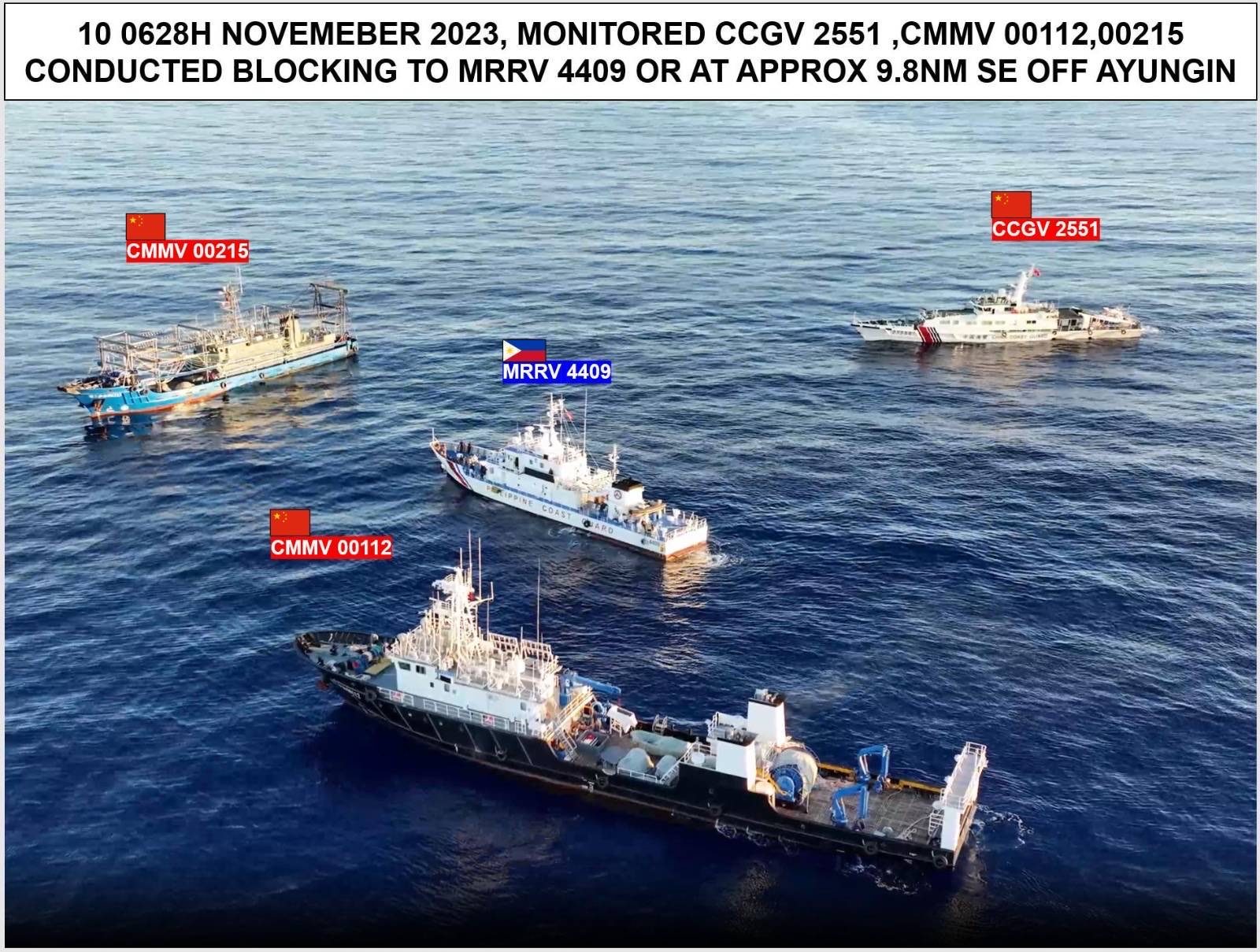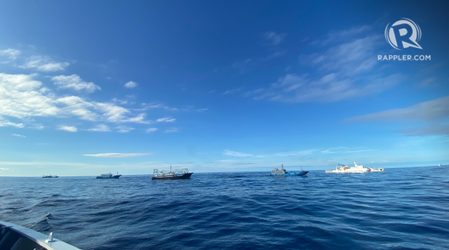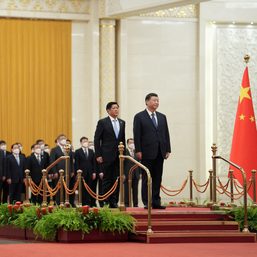SUMMARY
This is AI generated summarization, which may have errors. For context, always refer to the full article.

MANILA, Philippines – The Philippines on Thursday, November 16, called on China to remove all its “illegal structures” in the Spratlys, an archipelago of islands, cays, and reefs that’s rich in marine life and, possibly, oil and gas.
“We call on China to remove all these illegal structures, cease reclamations in the South China Sea, and be accountable for the damages caused by these illegal activities,” Department of Foreign Affairs spokesperson Teresita Daza said in a statement in response to an earlier claim by her Chinese counterpart in relation to a November 10 Philippine Navy resupply mission to Ayungin Shoal.
“We are being asked to give prior notification each time we conduct a resupply mission to Ayungin Shoal. We will not do so. The resupply missions are legitimate activities within our EEZ, in accordance with international law,” she added.
Daza was addressing claims made by Chinese Foreign Ministry Spokesperson Wang Wenbin, following a November 10 Philippine Navy resupply mission to Ayungin Shoal, where a World War II-era warship serves as the Philippines’ permanent outpost.
Ayungin Shoal, part of the Spratlys, is a low-tide elevation that is well within the Philippines’ exclusive economic zone (EEZ) – a status affirmed by a 2016 arbitral award, based on the United Nations Convention on the Law of the Sea.
This means Manila has the exclusive rights to the resources in the area, including marine life and possible energy deposits.
Harassment in Ayungin
On November 10, Chinese vessels harassed and blocked Philippine Coast Guard (PCG) and military-contracted ships who were bringing supplies for a small team of Marines stationed at the BRP Sierra Madre. The China Coast Guard, as it had done in the past, used water cannons against one of two resupply ships.
While the mission was a success, with the PCG getting the closest it had ever gotten to the Sierra Madre, Philippine officials expressed concern over what the PCG chief described as “systematic and consistent” dangerous actions by their Chinese counterparts.
China’s harassment in Ayungin has become as regular as the resupply missions themselves.
China claims practically all of the South China Sea, despite the 2016 arbitral award declaring it invalid. It has repeatedly insisted that Philippine resupply missions are cases of “intrusion” that violate China’s “sovereignty.”
“China will continue to take necessary measures in accordance with law to firmly safeguard our territorial sovereignty and maritime rights and interests,” said Wang in a statement on November 10, the day of the resupply mission to Ayungin Shoal.
In response, Daza said: “The reason presented by China for such challenges and dangerous maneuvers is sovereignty and exercise of lawful enforcement activity over what is allegedly territory. But the law is clear: Ayungin Shoal is not an island; it is a low-tide elevation that cannot be appropriated or subjected to sovereignty claims.”
Ayungin Shoal is located some 106.3 nautical miles away from Palawan. It is over 617.39 nautical miles from the Chinese mainland.
“The resupply mission to and the upkeep of the BRP Sierra Madre are legitimate Philippine Government activities in our EEZ, and in accordance with international law, particularly UNCLOS. It is difficult to imagine how these activities could be deemed threatening to China,” said Daza.
The grounding of the Sierra Madre
The BRP Sierra Madre embarked on its final mission in 1999 to serve as a permanent outpost in Ayungin Shoal. In her statement on November 16, Daza reminded China why the Philippines had to take such an unusual and drastic move.
“The BRP Sierra Madre is a commissioned Philippine naval vessel permanently stationed in Ayungin Shoal in 1999 to serve as a constant Philippine government presence in response to China’s illegal occupation in 1995 of Panganiban Reef, also known as Mischief Reef. This was prior to the signing of the DOC in 2002,” she said.
China established a supposed fisherman’s shelter on Mischief Reef in 1995 but the Philippines would later witness the transformation of the reef into an artificial island with a runway. China has done the same with other structures in the South China Sea. Reclamation efforts sped up between 2013 and 2016, from the time the Philippines filed its case against China to the decision of the arbitral tribunal favoring the Philippines.
“The reef is now a militarized artificial island. So are Calderon Reef, also known as Cuarteron Reef; Kagitingan Reef, also known as Fiery Cross Reef; Burgos Reefs, also known as Gaven Reefs; McKennan Reef, also known as Hughes Reef; Johnson Reef; and Zamora Reef, also known as Subi Reef. Let us not forget that,” Daza said.
Despite the 2016 arbitral ruling, support from other countries on the ruling, and calls for China to respect international law, Beijing has refused to budge – insisting that the ruling is invalid.
“The Philippines has not entered into any agreement abandoning its sovereign rights and jurisdiction over its EEZ and continental shelf, including in the vicinity of Ayungin Shoal,” said Daza.
US reaffirms commitment to PH defense
Amid increasing tensions between the Philippines and China, US leaders reiterated their commitment to come to the defense of the Philippines’ sovereign rights and jurisdiction in the South China Sea.
President Ferdinand Marcos Jr. and Vice President Kamala Harris, in a meeting in San Francisco, California, ahead of the Asia-Pacific Economic Cooperation (APEC) Summit, “reaffirmed the strength of the alliance between the United States and the Philippines and discussed ongoing efforts to deepen our security ties and expand commercial and economic cooperation,” according to a readout from Harris’ office.
“They also reiterated their shared commitment to upholding international rules and norms, including in the South China Sea,” it added.
During the meeting, Harris’ office said she reiterated that the US “stands shoulder-to-shoulder in defending the Philippines’ sovereign rights and jurisdiction in the South China Sea and reaffirmed the United States’ defense commitment to the Philippines under Article IV of the 1951 US-Philippines Mutual Defense Treaty, underscoring that an armed attack on Philippine armed forces, public vessels, or aircraft in the Pacific, including in the South China Sea, would invoke US mutual defense commitments.”
A day earlier, US Defense Secretary Lloyd Austin expressed the same commitment during a meeting with Philippine Defense Secretary Gilberto Teodoro in Jakarta, Indonesia. – Rappler.com
Add a comment
How does this make you feel?










There are no comments yet. Add your comment to start the conversation.